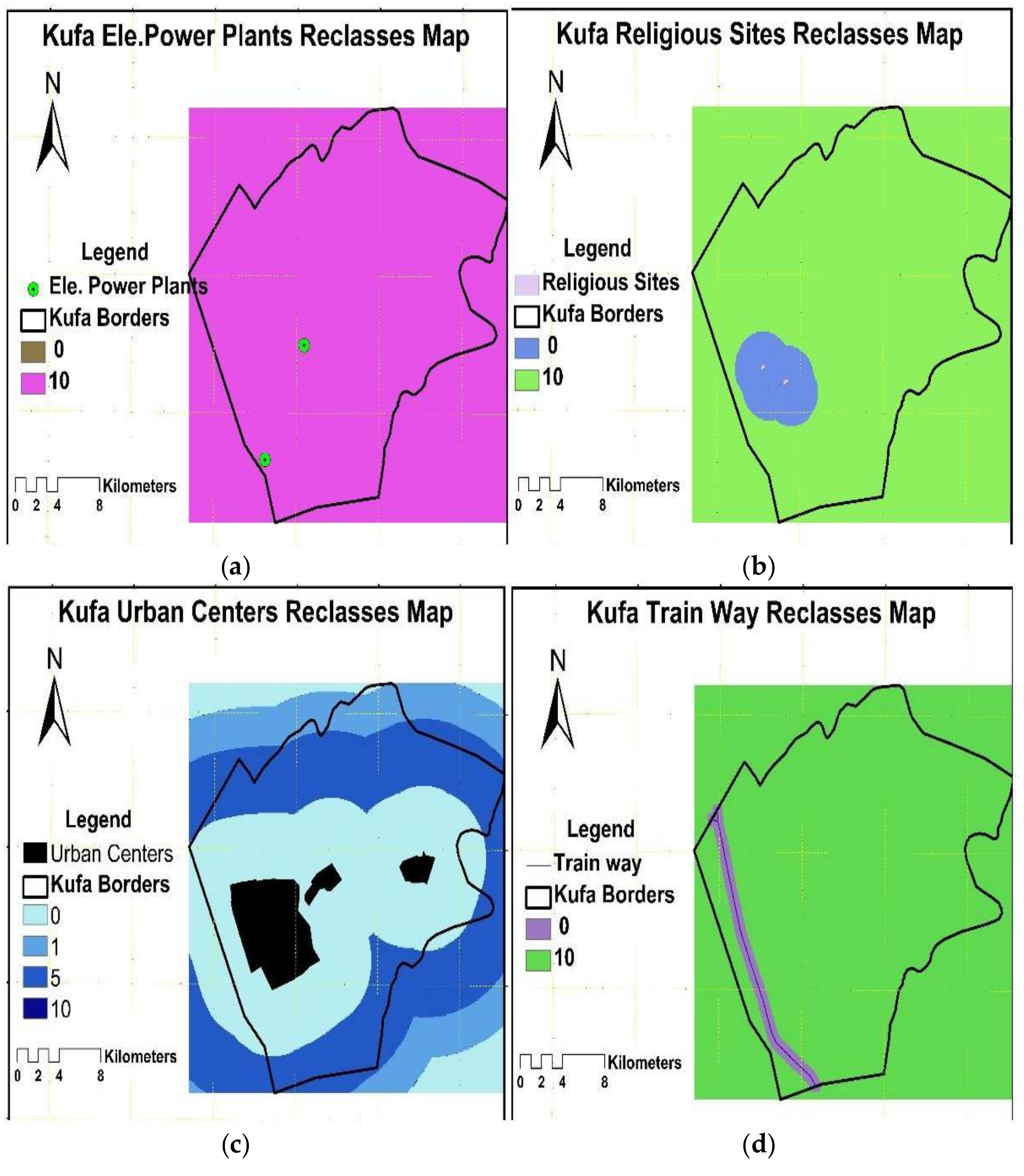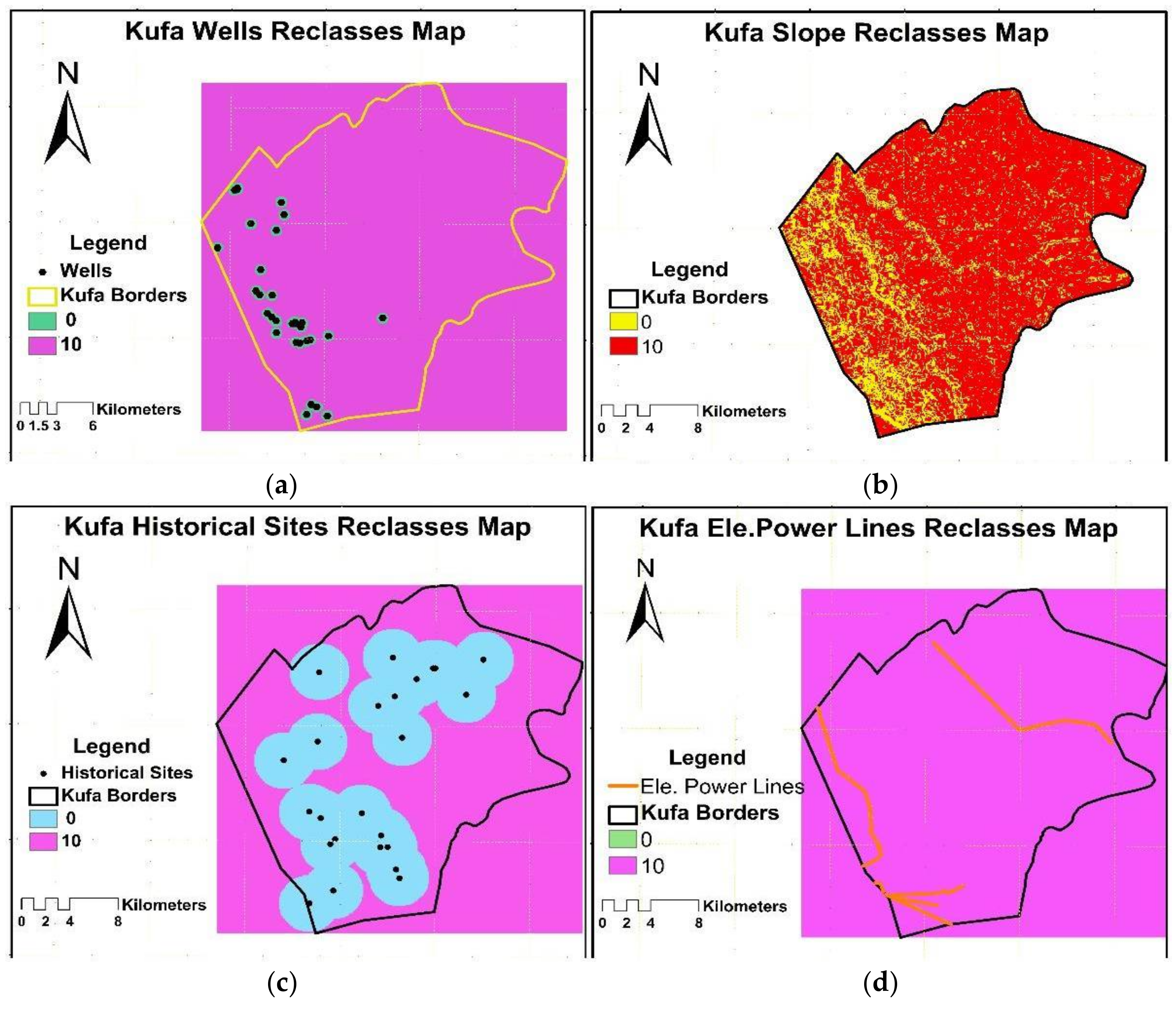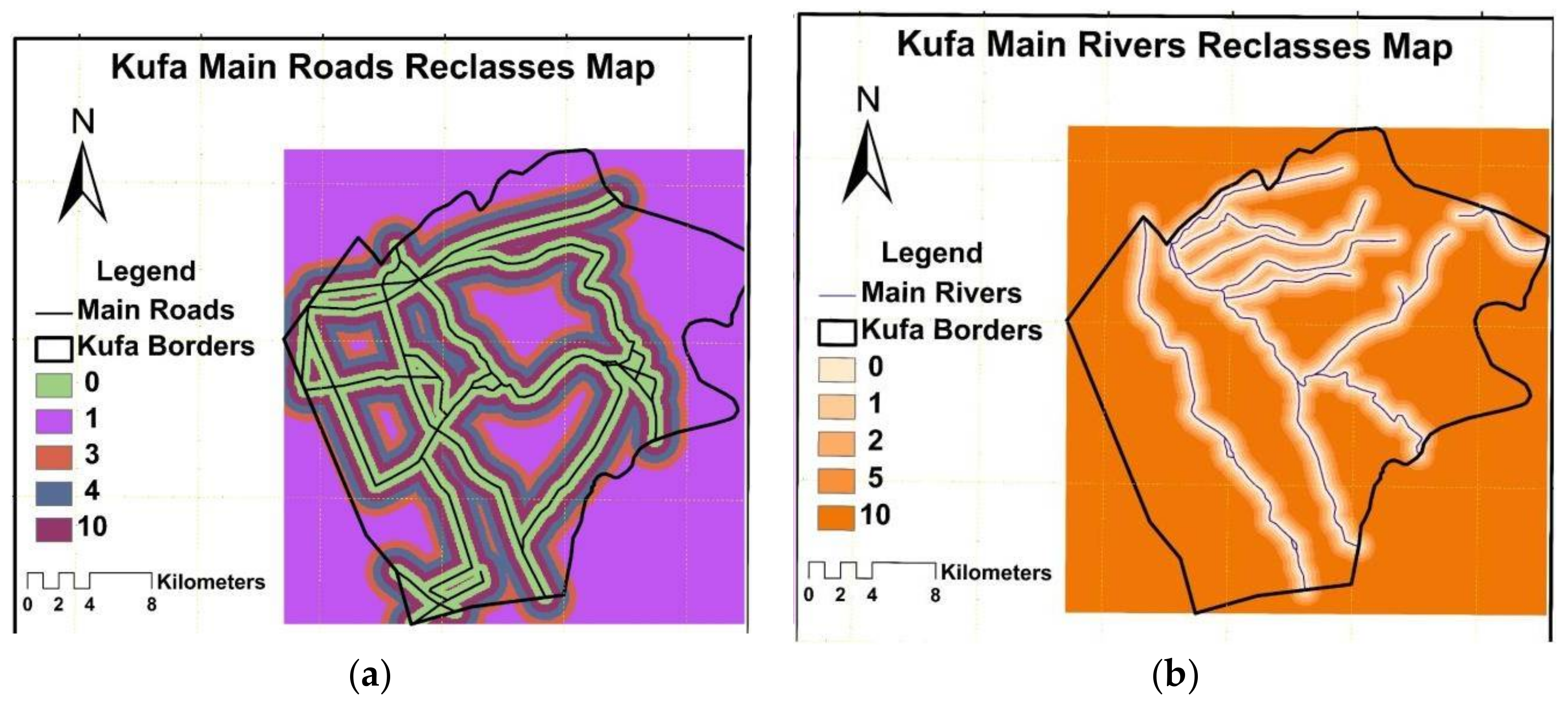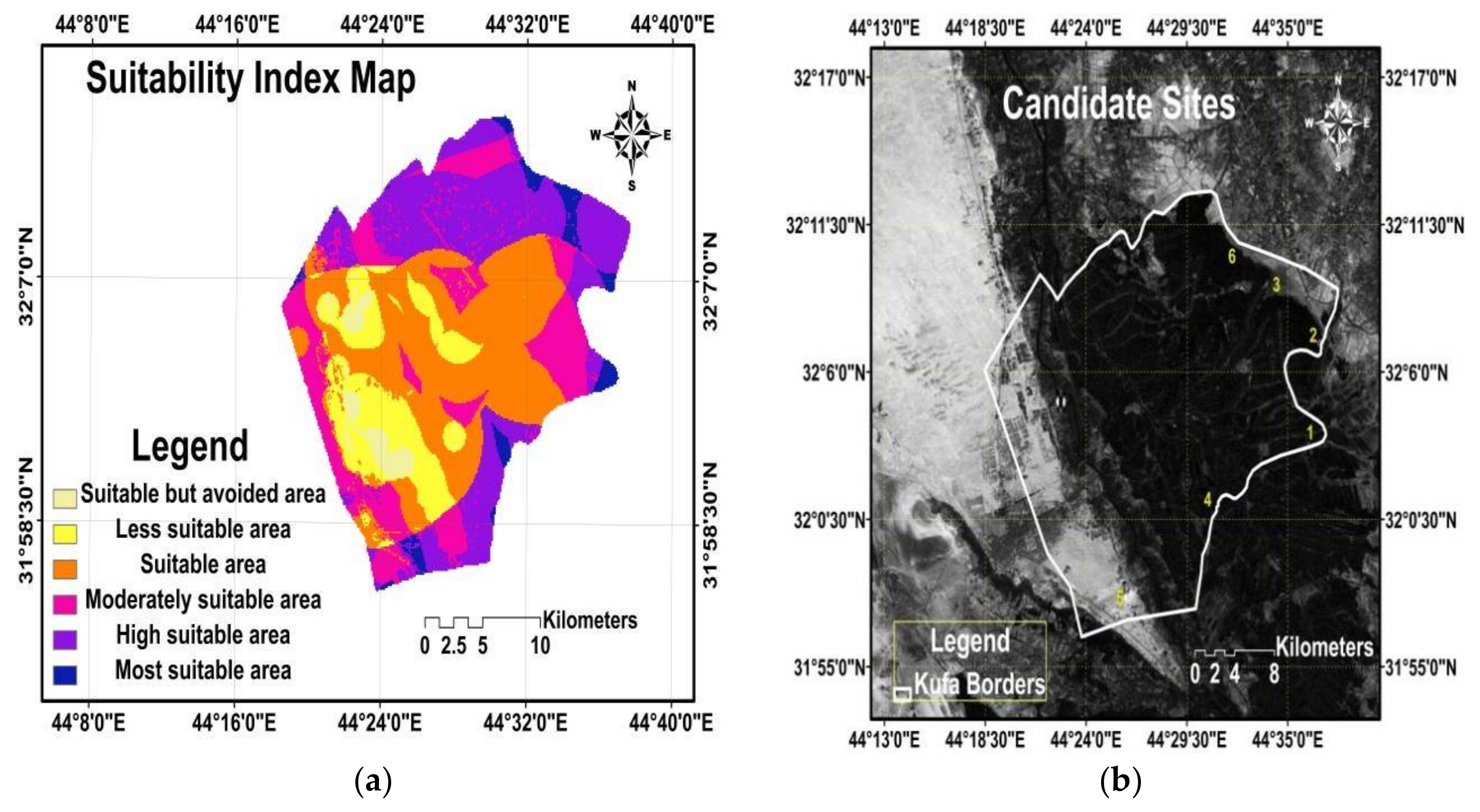Landfill Site Selection by Weighted Overlay Technique: Case Study of Al-Kufa, Iraq
Abstract
:1. Introduction
2. Materials and Methods
2.1. Study Area
2.2. Methodology
2.3. Integration of Multi-Criteria Decision Analysis (MCDA) with GIS
2.4. Inhabitants Estimation and Municipal Solid Waste Volume for Study Area during Period (2017–2032)
2.5. Criteria Analysis
2.5.1. Criteria Weights
2.5.2. Digital Environmental Maps
2.5.3. Identification of Optimum Site for Landfill Localization
3. Results and Discussion
4. Conclusions
- Al-Kufa municipality office should apply the ISWM tool, to look at solid wastes as an economic resource. Such practices may add economic benefits to landfill construction, as well as keeping the site to work for a longer period of time.
- The total amount of solid waste generated during (2017–2032) is about (1000) tonne (2000 m3).
- The area with class of most suitable area is about 28 km2 (5% from total study area) distributed in six sites in south and north east for Al-Kufa city.
- The most important criteria is urban center; it took about 32% from all criteria weights.
- Including a construction material availability layer into the proposed model.
- Adopting an agricultural areas layer to be excluded because of the importance of this criteria.
- Implementing sanitary landfill sites (architectural, structural, mechanical, etc.) to be used in the selected sites.
Acknowledgments
Author Contributions
Conflicts of Interest
References
- Alanbari, M.A.; Al-Ansari, N.; Jasim, H.K.; Knutsson, S. Al-Mseiab Qadaa Landfill Site Selection Using GIS and Multicriteria Decision Analysis. Engineering 2014, 6, 526–549. [Google Scholar] [CrossRef]
- Goulart Coelho, L.M.; Lange, L.C. Applying life cycle assessment to support environmentally sustainable waste management strategies in Brazil. Resour. Conserv. Recycl. 2018, 128, 438–450. [Google Scholar] [CrossRef]
- Ferronato, N.; Torretta, V.; Ragazzi, M.; Rada, E.C. Waste mismanagement in developing countries: A case study of environmental contamination. UPB Sci. Bull. Ser. D 2017, 79, 185–196. [Google Scholar]
- Kolekar, K.A.; Hazra, T.; Chakrabarty, S.N. Prediction of municipal solid waste generation for developing countries in temporal scale: A fuzzy inference system approach. Glob. Nest J. 2017, 19, 511–520. [Google Scholar]
- Lin, H.; Kao, J. Enhanced Spatial Model for Landfill Siting Analysis. J. Environ. Eng. 1999, 125, 845–851. [Google Scholar] [CrossRef]
- Jamshidi-Zanjani, A.; Rezaei, M. Landfill site selection using combination of fuzzy logic and multi-attribute decision-making approach. Environ. Earth Sci. 2017, 76, 448. [Google Scholar] [CrossRef]
- Majumdar, A.; Hazra, T.; Dutta, A. Landfill Site Selection by AHP Based Multi-criteria Decision Making Tool: A Case Study in Kolkata, India. J. Inst. Eng. (India) Ser. A 2017, 98, 277–283. [Google Scholar] [CrossRef]
- Rafiee, R.; Nematolah, K.; Abdolrassoul, S.M.; Ali, A.D.; Afshin, D.; Syed, E.H. Siting Transfer Station for Municipal Solid Waste Using a Spatial Multi-Criteria Analysis. Environ. Eng. Geosci. 2011, 17, 143–154. [Google Scholar] [CrossRef]
- Oppio, A.; Corsi, S. Territorial vulnerability and local conflicts perspectives for waste disposals siting. A case study in Lombardy region (Italy). J. Clean. Prod. 2017, 141, 1528–1538. [Google Scholar] [CrossRef]
- Rafiee, R. Site Selection for Waste Transfer Station with Regard to Urban Growth Trend (Mashhad Case Study); University of Tehran: Tehran, Iran, 2007; p. 105. [Google Scholar]
- Phillips, J.A. Managing Americas Solid Waste; National Renewable Energy Laboratory Report NREL/SR-570-25035; A National Laboratory of the U.S. Department of Energy: Boulder, CO, USA, 1998.
- Richárd, S. Waste Management Facility Siting and Social Conflicts—The Case of Hungary. In Integrated Waste Management—Volume I; InTech: London, UK, 2011. [Google Scholar] [CrossRef]
- Chabuk, A.; Al-Ansari, N.; Hussain, H.M.; Knutsson, S.; Pusch, R. Landfill Site Selection Using Geographic Information System (GIS) and AHP: A Case Study Al-Hillah Qadhaa, Babylon, Iraq. Waste Manag. Res. 2016, 34, 427–437. [Google Scholar] [CrossRef] [PubMed]
- Directorate of Statistics Najaf Governorate. Indicators Base Al-Najaf Governorate; Directorate of Statistics Najaf Governorate: Najaf, Iraq, 2015.
- Water Resources of Najaf Governorate; Najaf Water Resources Directorate: Najaf, Iraq, 2015.
- Archeological Sites in Najaf; Najaf Archetecheral Planning Directorate, Najaf Governorate: Najaf, Iraq, 2015.
- Al-Ansari, N.A.; Pusch, R.; Knutsson, S. Suggested Landfill Sites for Hazardous Waste in Iraq. Nat. Sci. 2013, 5, 463–477. [Google Scholar] [CrossRef]
- Şener, B.; Süzen, M.L.; Doyuran, V. Landfill Site Selection by Using Geographic Information Systems. Environ. Geol. 2006, 49, 376–388. [Google Scholar] [CrossRef]
- Saaty, T.L. Decision making with the analytic hierarchy process. Int. J. Serv. Sci. 2008, 1, 83–98. [Google Scholar] [CrossRef]
- Allen, A.R. Attenuation: A Cost Effective Landfill Strategy for Developing Countries. In Proceedings of the 9th Congress of the International Association for Engineering Geology and the Environment, Durban, South Africa, 16–20 September 2002; pp. 136–147. [Google Scholar]
- Al-Anbari, M.A.; Thameer, M.Y. Landfill Site Selection by Using Pairwise Comparison, Rating, Ranking and Trade-off Methods for Criteria Weighting. Int. J. Civ. Eng. Technol. 2015, 6, 111–123. [Google Scholar]
- Sener, B. Landfill Site Selection by Using Geography Information System. MSc Dissertation, Middle East Technical University, Ankara, Turkey, 2004. [Google Scholar]
- Alanbari, M.A.; Thameer, M.Y.; Al-Ansari, N.; Knutsson, S. Landfill Site Selection in Al-Najaf Governorate, Iraq. J. Civ. Eng. Arch. 2016, 10, 651–660. [Google Scholar] [CrossRef]
- Demesouka, O.; Vavatsikos, A.; Anagnostopoulos, K. Suitability analysis for siting MSW landfills and its multicriteria spatial decision support system Method, implementation and case study. Waste Manag. 2013, 33, 1190–1206. [Google Scholar] [CrossRef] [PubMed]
- Yager, R.R. On ordered weighted averaging aggregation operators in multicriteria decision making. IEEE Trans. Syst. Man Cybern. 1988, 18, 183–190. [Google Scholar] [CrossRef]
- Malczewski, J. Propogation of errors in multicriteria location analysis: A case study. In Multiple Criteria Decision Making; Fandel, G., Gal, T., Eds.; Springer: Berlin, Germany, 1997; pp. 154–155. [Google Scholar]
- Kirkwood, C.W. Strategic Decision Making: Multi Objective Decision Analysis with Spreadsheets; Duxbury Press: Belmont, Australia, 1997. [Google Scholar]
- Al-Anbari, M.A.; Thameer, M.Y.; Al-Ansari, N.; Knutsson, S. Estimation of Domestic Solid Waste Amount and Its Required Landfill Volume in Najaf Governorate-Iraq for the Period 2015–2035. Engineering 2016, 8, 339–346. [Google Scholar] [CrossRef]
- Thomas, H.C. Solid Waste Technology & Management; John Wiley and Sons Publishing Ltd.: Chichester, UK, 2010; p. 1052. [Google Scholar]
- Alanbari, M.A.; Al-Ansari, N.; Jasim, H.K.; Knutsson, S. Modeling Landfill Suitability Based on GIS and Multicriteria Decision Analysis: Case Study in Al-Mahaweelqadaa. Nat. Sci. 2014, 6, 828–851. [Google Scholar] [CrossRef]






| Year | Inhabitants | Solid Waste Amount (kg) |
|---|---|---|
| 2017 | 372,760 | 56,361 |
| 2018 | 382,079 | 57,770 |
| 2019 | 391,631 | 59,215 |
| 2020 | 401,422 | 60,695 |
| 2021 | 411,458 | 62,212 |
| 2022 | 421,744 | 63,768 |
| 2023 | 432,288 | 65,362 |
| 2024 | 443,095 | 66,996 |
| 2025 | 454,172 | 68,671 |
| 2026 | 465,527 | 70,388 |
| 2027 | 477,165 | 72,147 |
| 2028 | 489,094 | 73,951 |
| 2029 | 501,321 | 75,800 |
| 2030 | 513,854 | 77,695 |
| 2031 | 526,701 | 79,637 |
| 2032 | 539,868 | 81,628 |
| Criteria | Weight | Criteria | Weight | λmax | CI | RI | CR |
|---|---|---|---|---|---|---|---|
| UC | 0.32 | SL | 0.07 | 12.3508 | 0.13508 | 1.51 | 0.0894 < 0.1 O.K |
| MR | 0.21 | EL | 0.04 | ||||
| HS | 0.07 | RO | 0.09 | ||||
| NR | 0.04 | RW | 0.03 | ||||
| WE | 0.02 | RS | 0.04 | ||||
| EP | 0.07 | ||||||
| Criteria | Variable Used (m) | Ranking (0–10) | Description Ranking Scale | Researchers’ Suggested Buffers |
|---|---|---|---|---|
| Urban center | 0–5000 | 0 | Not suitable | 5000 m [1], 5000 m [20], 5000 m [21] |
| 5000–10,000 | 10 | Most suitable | ||
| 10,000–15,000 | 5 | High Suitable | ||
| >15,000 | 1 | Less suitable | ||
| Main river | 0–250 | 0 | Not suitable | 250 m [1], 1000 m [13] |
| 250–500 | 1 | Less suitable | ||
| 750–1000 | 3 | Moderately suitable | ||
| >1000 | 10 | Most suitable | ||
| Railways | 0–500 | 0 | Not suitable | 500 m [13], 500m [1] |
| >500 | 10 | Most suitable | ||
| Power lines | 0–300 | 0 | Not suitable | 30 m [22], 30 m [23] 50 m [24] |
| >300 | 10 | Most suitable | ||
| Power plant | 0–500 | 0 | Not suitable | 250 m [21], 250 m [23] |
| >500 | 10 | Most suitable | ||
| Slope | 0–15% | 10 | Most suitable | 5% [22], 15% [1] |
| >15% | 0 | Not suitable | ||
| Historical sites | 0–2500 | 0 | Not suitable | 1500 m [21] |
| >2500 | 10 | Most suitable | ||
| Religious sites | 0–2500 | 0 | Not suitable | 1500 m [21] |
| >2500 | 10 | Most suitable | ||
| Well | 0–500 | 0 | Not suitable | 400 m [23], 400 m [21] |
| >500 | 10 | Most suitable | ||
| Roads | 0–500 | 0 | Not suitable | 500 m [21], 500 m [23] |
| 500–1000 | 10 | Most suitable | ||
| 1000–1500 | 4 | suitable | ||
| 1500–2000 | 3 | Moderately suitable | ||
| >2000 | 1 | Less suitable | ||
| Nature reserves | 0–500 | 0 | Not suitable | 400 m [21], 400 m [23] |
| >500 | 10 | Most suitable |
| Accumulated Waste from 2017 to 2032 Weight (tonne) * | Volume in Landfill (m3) * | |
|---|---|---|
| Al-Kufa | 1093 | 1951 |
| Al-Kufa Landfill | |
|---|---|
| Accumulated Volume (m3) | 1951 |
| +12% Cover | 234.12 |
| Total volume(m3) | 2185.12 |
| Area m2 for 3 m depth | 728.3 |
© 2018 by the authors. Licensee MDPI, Basel, Switzerland. This article is an open access article distributed under the terms and conditions of the Creative Commons Attribution (CC BY) license (http://creativecommons.org/licenses/by/4.0/).
Share and Cite
Al-Anbari, M.A.; Thameer, M.Y.; Al-Ansari, N. Landfill Site Selection by Weighted Overlay Technique: Case Study of Al-Kufa, Iraq. Sustainability 2018, 10, 999. https://doi.org/10.3390/su10040999
Al-Anbari MA, Thameer MY, Al-Ansari N. Landfill Site Selection by Weighted Overlay Technique: Case Study of Al-Kufa, Iraq. Sustainability. 2018; 10(4):999. https://doi.org/10.3390/su10040999
Chicago/Turabian StyleAl-Anbari, Mohammad A., Mohanad Y. Thameer, and Nadhir Al-Ansari. 2018. "Landfill Site Selection by Weighted Overlay Technique: Case Study of Al-Kufa, Iraq" Sustainability 10, no. 4: 999. https://doi.org/10.3390/su10040999






